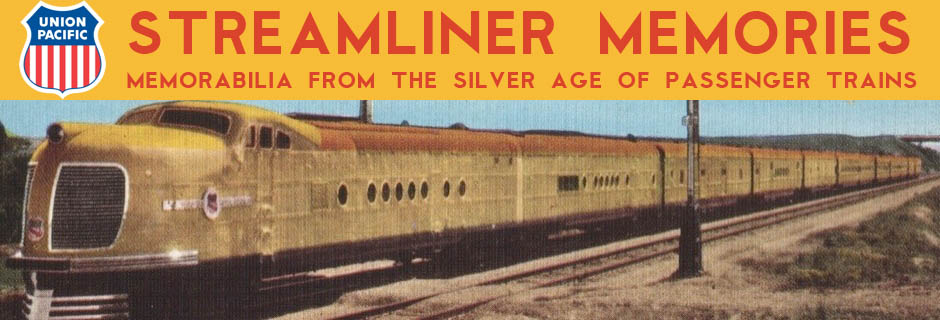In the 1920s, the New York Central and Pennsylvania were the only railroads that could take passengers between New York and Chicago in 20 hours, but they still had to compete with other railroads for East Coast-Midwest passengers. The most important was probably the Baltimore & Ohio.
 Click image to download a 6.5-MB PDF of this 36-page booklet.
Click image to download a 6.5-MB PDF of this 36-page booklet.
We’ve seen a “book of trains” before published by the Union Pacific Railroad. That one was dated 1929, while this one is 1928, so perhaps UP borrowed the idea from the B&O. The UP booklet focused on trains between Chicago and Denver, Los Angeles, San Francisco, and Portland. By skipping its many shorter routes, UP was able to devote two pages to each train.
The B&O booklet is almost the same size and has the same number of pages as the UP one, but it includes a lot of shorter-distance trains such as Wheeling-Baltimore, Louisville-Cincinnati, and New York-Washington. As a result, it only allows one page each for major trains and just a half a page for some minor routes. For most trains, the booklet provides an eastbound schedule and a list of equipment used on that train. Westbound New York-Chicago and New York-St. Louis schedules are condensed onto one page.
Other than the Capitol Limited and National Limited, few of the trains have evocative names. A train called the Metropolitan Special goes between St. Louis and New York, but a train of that name could go between any two major cities in the country. The Pennsy, for example, had a Chicago-New York train called the Metropolitan Express. The Fort Pitt Limited does a little better, going between Chicago and Pittsburgh. The Detroit-Washington Limited fails, however, as it actually goes between Detroit and Baltimore (via Washington).
The eastbound schedules show a Washington-New York Special, a Washington-New York Night Express (both coming from Chicago) and a Washington-New York Express (coming from Louisville). The trains in the reverse direction might have been called the “Chicago Special” or “Louisville Express,” but there doesn’t seem to be a westbound counterpart to the Washington-New York Night Express.
According to the B&O’s 1948 timetable, the train called the Washington-New York Express would later be renamed the Shenandoah; the train called the Detroit-Washington Limited would be renamed the Ambassador; and the numbers for the Washington-New York Express from Louisville would be assigned to the St. Louis-New York Diplomat. Even in 1948, some trains would still be called Chicago Express or New York Express and the Metropolitan Express would retain its uninformative name.
B&O’s main line was between Jersey City & Chicago, with an additional line to St. Louis. But it was a distinct also-ran to the New York Central and Pennsylvania railroads, especially after the latter terminated the B&O’s access to New York Penn Station in 1926, as previously noted here.
According to this booklet, B&O offered four trains a day between Jersey City and Chicago, with the fastest taking just over 24 hours plus another 30 to 40 minutes to take a ferry/bus into Manhattan. In 1928 the Central and Pennsy each had eight trains a day between Manhattan and Chicago, with the fastest taking only 20 hours, soon to be reduced to 18 and then 16. They also had six trains between New York and St. Louis compared to B&O’s two.
When the Pennsylvania Railroad stopped allowing the B&O to enter New York City’s Penn Station on PRR tracks in 1926, B&O was forced to terminate its trains in Jersey City. According to Lucius Beebe’s book, 20th Century, the B&O got its revenge in 1935 when the New York Central allowed it to use Pittsburgh and Lake Erie tracks for part of its Washington-Chicago Capitol Limited route, which competed directly with PRR’s Liberty Limited.
“This strategem,” wrote Beebe in his usual florid prose, “an intrigue worthy of a Borgia, gave the B & O a substantial time advantage over the Pennsylvania on the long Washington-Chicago haul and placed the Liberty at a disadvantage compared to the Capitol Limited. The Liberty Limited came to an end in 1957 after nearly a quarter of a century of service, a victim of assassination as subtly conceived as any by a Florentine price of the cinquecento.” In truth, the Capital Limited was less than an hour faster than the Liberty Limited, and an assassination can hardly be considered a great success if it takes 22 years to work, but the faster train must have been satisfying to B&O officials.

The Liberty wasn’t just done in by being a little bit slower. B & O management was still pro-passenger into the 1960s; the same cannot be said for the Pennsylvania. Others have written that the food offered on the Capitol was head-and-shoulders above the Liberty.
IIRC, even after the Liberty came off, through car service from DC to Chicago was offered on the General, with the DC cars connecting at Harrisburg.